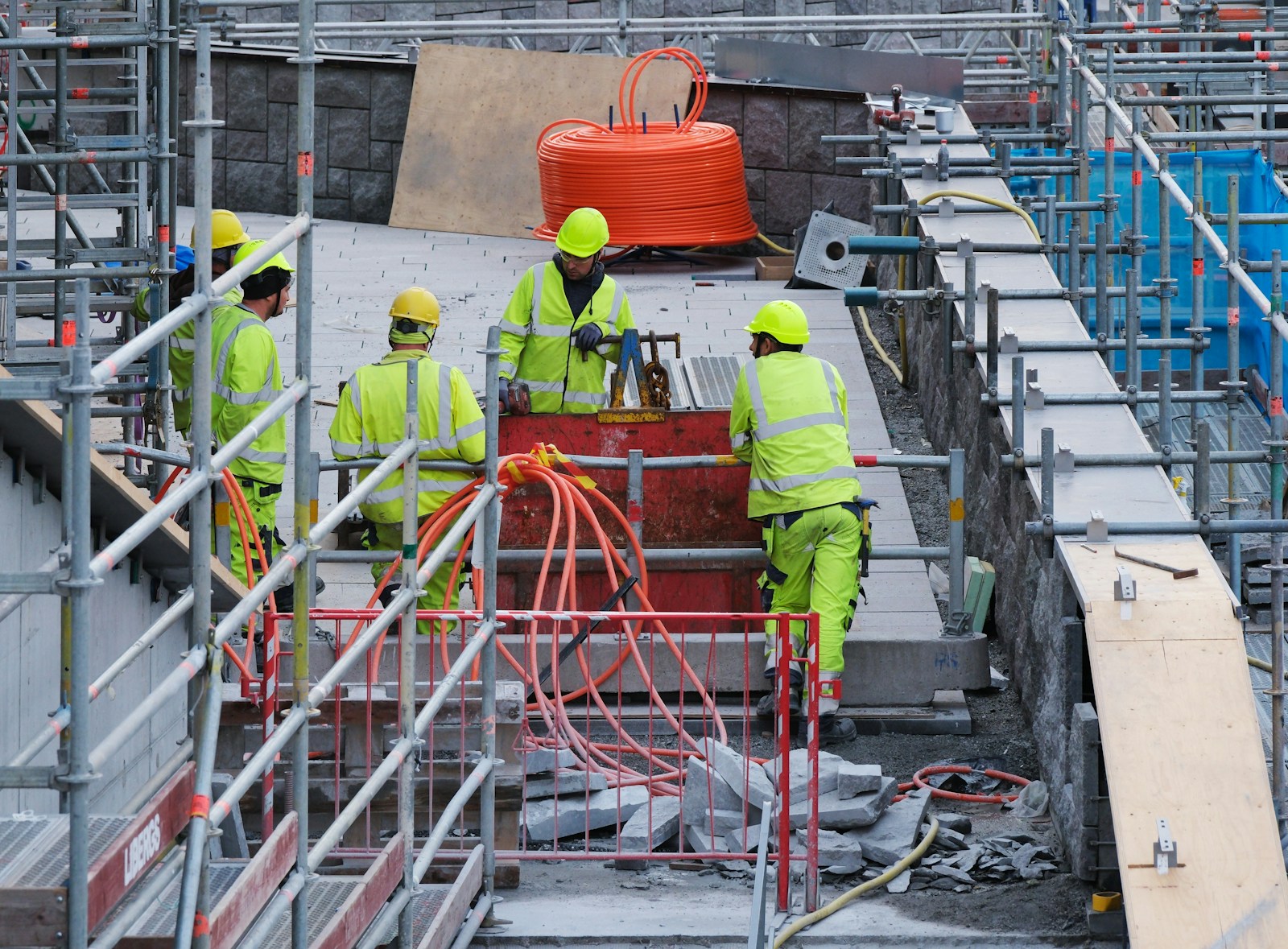Part 2: The Evolution Up Close
After exploring the broad sweep of industrial relations changes in Part 1, let’s delve deeper into how these transformations played out in real workplaces, with real people, facing real challenges.
The Foundation Years (1974-1983)
When I started in the Personnel Section of the Queensland Department of Education in 1974, industrial relations was a different world. Picture rooms full of filing cabinets, manual typewriters, and ledger books for recording employee details. The system was highly centralised, rigid, and hierarchical.
My move to the Queensland Public Service Board marked my first real exposure to the complexities of public sector industrial relations. The contrast between policy and practice became stark when I found myself working on productivity assessments for units as diverse as the Homicide Squad and Drug Squad – a far cry from updating microfiche at the State Library!
The copper refineries of MIM Holdings provided my first taste of private sector industrial relations. Here, in one of Australia’s largest companies by market capitalisation, I learned that effective industrial relations required more than just understanding rules and regulations – it demanded an appreciation of operational realities and human dynamics.
The Reform Era (1983-1994)
The Accord years brought a fundamental shift in how industrial relations operated in Australia. At Newlands Coal, operating under the specialised Coal Industry Tribunal, I witnessed firsthand how this unique system managed industrial relations in one of Australia’s most crucial sectors.
A defining moment of this era was the Pilots’ Dispute (1989-1990). While I was at CIG Gases, this dispute demonstrated how industrial action could impact the entire nation. The dispute, which effectively grounded domestic air travel, showed the potential consequences of industrial relations failures and the importance of maintaining dialogue even in the most challenging circumstances.
My executive role at CIG Gases (1989-1993) coincided with the transition to enterprise bargaining. Leading HR strategy for a 500-strong workforce across Victoria and Tasmania during this pivotal time taught me valuable lessons about managing change in a highly technical industry. We weren’t just dealing with award modernisation – we were fundamentally rethinking how workplace relations operated.
The Transition Years (1994-1998)
The mid-1990s brought some of the most significant changes to Australian industrial relations, and I had a front-row seat at Drayton Coal. The dissolution of the Coal Industry Tribunal in 1995 marked the end of an era in specialised industrial relations management.
The 1997 Drayton Coal restructure remains one of the most challenging and instructive experiences of my career. When coal prices halved overnight, we faced a critical choice: conflict or collaboration. The decision to establish an employment centre rather than engage in protracted legal battles proved transformative. While other mining companies faced extended industrial action, we achieved our objectives through partnership and dialogue.
This period taught me that the most effective industrial relations strategies often emerge from crisis. The key is maintaining relationships and trust even when making difficult decisions.
The Transformation Period (1998-2009)
The Waterfront Dispute of 1998 represented a watershed moment in Australian industrial relations. While not directly involved, every industrial relations practitioner watched closely as this dispute tested the limits of workplace reform and reshaped public discourse about industrial relations.
The WorkChoices era brought unprecedented change and controversy to Australian workplaces. The legislation’s impact varied significantly across industries, highlighting the importance of understanding both the letter of the law and its practical implications for different workplace contexts.
The early 2000s brought a personal transition as I moved to London to work in Shell’s head office. This international experience, while valuable, meant that upon my return to Australia in 2004, I faced the challenge of rapidly reconnecting with the Australian industrial relations landscape. This homecoming coincided with my appointment at Curragh Coal Mine, where I would need to quickly reorient myself to local conditions while managing a significant operational expansion.
Managing Complex Workforce Models: The Curragh Experience (2004-2008)
My role as Head of HR, IR, Health and Safety at Curragh Coal Mine in Blackwater, Central Queensland, presented a unique challenge in managing workforce transformation and expansion. Owned by Wesfarmers Resources, Curragh was about to embark on a significant expansion that would test our ability to maintain reputation and standards across distinct operating models.
The Expansion Challenge
The development of Curragh North presented both an opportunity and a challenge. We needed to:
- Expand operations from 400 to nearly 1,000 personnel
- Establish clear operational boundaries
- Maintain distinct yet consistent standards
- Ensure community confidence during rapid growth
The Mixed Workforce Model
We created a deliberately separated operating structure where:
- Company employees operated Curragh East
- THEISS Holdings operated Curragh North as an independent contractor
- Clear ring-fencing between operations
- Each operation maintained its own support functions and facilities
Managing Distinct Operations
Key to our success was:
- Clear Governance Frameworks
- Established distinct operational boundaries
- Developed separate management systems
- Created clear reporting protocols
- Maintained transparent but separate processes
- Relationship Management
- Regular updates on industrial matters from THEISS Holdings
- Clear communication channels between operations
- Distinct operational autonomy
- United front for community relations
- Compliance and Safety
- THEISS Holdings responsible for their own IR management
- Health and Safety management plan approval by Curragh
- Independent implementation by THEISS Holdings
- Maintaining consistent safety standards while respecting operational independence
Lessons from Curragh
The experience demonstrated that:
- Clear operational boundaries enhance effectiveness
- Contractor autonomy can coexist with corporate standards
- Community perception requires coordinated approach
- Distinct operations can maintain separate identities while sharing corporate reputation
- Clear delineation of responsibilities strengthens accountability
The Modern Era (2010-2024)
Yancoal Transformation (2010-2013)
Returning from the Middle East to join Yancoal Australia as Executive General Manager People presented a unique challenge: growing from one mine with 300 employees to ten mines with 3,000 staff in just three years. This rapid expansion through mergers and acquisitions required careful management of multiple workplace cultures and industrial agreements.
By maintaining direct oversight of industrial relations rather than delegating it, we ensured consistency across all sites while managing the complexities of ASX listing requirements and diverse stakeholder expectations.
CleanCo Queensland: Navigating Complex Integration (2019-2022)
The establishment of CleanCo Queensland presented a masterclass in modern industrial relations complexity. This wasn’t merely about managing a start-up; it was about bringing together multiple workforce populations under unprecedented circumstances.
The Legislative Framework
The transfer process was underpinned by legislation and regulation, which mandated the movement of workers from existing power stations into the new entity. This wasn’t a choice for these employees – they were legislatively transferred, bringing with them their existing enterprise agreements, employment conditions, and industrial relationships. The legislation preserved their continuity of service, superannuation arrangements, and other entitlements.
A Tale of Two Workforces
Corporate Office:
- A diverse mix of employees including:
- Industry veterans who transferred from existing state electricity entities, bringing their enterprise agreements with them
- Self-selected employees choosing to join from other sectors
- New entrants to the energy industry attracted by the clean energy mission
- Complex industrial landscape with transferred EAs operating alongside new arrangements
- Negotiation of new corporate office enterprise agreement running parallel to integration
- Mixed levels of industry experience and knowledge
Power Station Sites:
- Legislatively transferred employees
- Deep operational experience
- Established industrial arrangements
- Strong union presence
- Initial uncertainty about the change
Building the ‘CleanCo Way’
We developed several strategic approaches to bridge these differences:
- Cultural Integration Framework
- Created shared values and behaviours
- Developed common language and goals
- Established consistent leadership practices
- Built a unified purpose around clean energy future
- Acknowledged and leveraged diverse industry experience
- Industrial Relations Strategy
- Managed multiple enterprise agreements across the corporate office
- Respected existing agreements while negotiating new corporate arrangements
- Maintained open dialogue with unions and delegates
- Developed consultation frameworks that worked across all employee groups
- Created transparent communication channels
- Balanced the needs of transferred and new employees in corporate office negotiations
The COVID-19 Challenge and Beyond
The COVID-19 pandemic tested our industrial relations frameworks in ways previously unimaginable. What made this period particularly fascinating was how it accelerated workplace changes that might otherwise have taken decades to evolve.
Key developments included:
- Rapid adoption of remote working arrangements
- Implementation of new safety protocols
- Changes to shift arrangements and work patterns
- Digital transformation of traditional workplace practices
- Evolution of consultation processes
The pandemic demonstrated both the resilience and adaptability of modern workplace relations systems, while also exposing areas needing reform.
Lessons for the Future
Looking back over five decades of industrial relations evolution, several key lessons emerge:
- Relationship Management is Paramount
- Trust and respect underpin successful industrial relations
- Maintain dialogue even during disputes
- Invest in stakeholder relationships before you need them
- Understand that relationships transcend formal structures
- Change is Constant
- Adapt to new circumstances while maintaining principles
- Balance innovation with tradition
- Learn from history while embracing new approaches
- Recognise that change management is a core IR skill
- Leadership Matters
- Direct engagement from senior leaders is crucial
- Consistent approaches yield better outcomes
- Strategic vision must align with operational reality
- Personal presence and visibility make a difference
- People Come First
- Technical excellence means nothing without human understanding
- Every workplace decision affects real people and families
- Long-term success requires genuine care for people’s wellbeing
- Cultural integration is as important as technical compliance
- Integration and Balance
- Managing diverse workforce populations requires consistent approaches
- Balance standardisation with flexibility
- Respect both heritage and future vision
- Acknowledge different starting points while building shared futures
Looking Forward
The next generation of industrial relations practitioners faces new challenges:
- Managing digital workforces
- Navigating environmental transitions
- Balancing flexibility with security
- Addressing technological disruption
- Managing multi-generational workforces
- Adapting to new forms of work
However, the fundamental skills remain the same – understanding people, building relationships, and finding common ground. As I tell young practitioners today, industrial relations isn’t just about knowing the laws and regulations – it’s about understanding how to bring people together to achieve common goals.
Final Reflections
After fifty years in industrial relations, I’ve learned that while legislation, technology, and workplace practices may change, the essential elements of successful industrial relations remain constant:
- Respect for people
- Clear and honest communication
- Focus on relationships
- Balance between competing interests
- Understanding of both human and business needs
The future of work will undoubtedly bring new challenges and opportunities. But if we maintain these core principles while embracing change, we can continue to build workplaces that serve both business needs and human aspirations.
As we look to the future, it’s worth remembering that the most successful industrial relations outcomes often emerge from the most challenging circumstances. The key is to maintain our focus on people while navigating the complex landscape of modern workplace relations.
The view from fifty years in industrial relations has been extraordinary. The journey continues, and the lessons learned will guide the way forward for the next generation of industrial relations practitioners.
[End of Part 2]























0 Comments